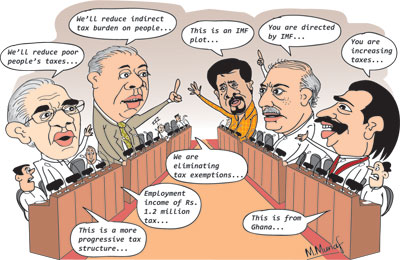Inland Revenue Bill: Higher revenue through progressive taxation
The proposed Inland Revenue Bill would increase government revenue, simplify the tax system, broaden the tax net and make it more equitable. Revenue would be increased by eliminating tax exemptions, reducing tax evasion and tax avoidance and increasing certain tax rates. The new tax regime is a step towards a more progressive tax structure in which direct taxes would become more significant.
 Economic rationale
Economic rationale
The fundamental economic rationale for this Inland Revenue Act is the vital need to garner adequate revenue for the country’s economic stability and development. There is a pressing need to increase government revenue through taxation for fiscal consolidation, macroeconomic stability and economic development.
Government revenue is inadequate to even meet its committed current expenditures. In certain years, government revenue has been inadequate to even meet debt servicing obligations, and in others, as much as 90 percent or more of revenue has been used for debt servicing alone. Consequently the government has had to borrow to meet its current and capital expenditure. This continuous need for the government to borrow to finance even its current expenditure is an underlying reason for the increasing public debt.
If the country is to resolve many of its fundamental macroeconomic problems, it requires to increase its revenue collection as well as enhance its expenditure on education, health and social and economic development. Reducing the fiscal deficit to 3.5 percent of GDP by 2020 as targeted by the government is imperative.
Inadequate revenue
Sri Lanka’s tax revenue has been well below what it should be at this stage of development. In fact tax revenue has decreased with increasing per capita income. In 1990, government revenue was 21 percent of GDP. At the turn of the century the tax to GDP ratio had fallen to 16.8 percent of GDP. By 2015 it had fallen further to 13 percent of GDP. In 2016 there was an increase in revenue to 14.3 percent of GDP. That is still much below other middle income countries with Sri Lanka’s per capita income that collects around 20 percent of GDP as revenue.
 Features
Features
Key provisions of the bill are the elimination of tax exemptions, introduction of a capital gains tax and new withholding taxes on income sources. Most corporate taxes have been increased. An important feature of the new law is that income tax exemptions are limited. Numerous tax exemptions have been a significant reason for the fall in government revenues. This move should enhance tax revenue.
Tax rates are streamlined with the present 10 sources of income regrouped under four sources: employment income, business income, investment income and other income. The progressive tax slabs for individuals have been revised. The tax free allowance of Rs.500,000 will remain the same for all citizens and residents. Capital gains tax has been introduced at 10 percent with some exemptions such as for share transactions.
Employment income
The present maximum tax rate of 16 percent on employment income has been removed and employed individuals will fall in line with the standard progressive tax slabs. However, qualifying payment relief on employment income of an individual has been increased from Rs.250,000 to Rs.700,000. Therefore employment income of Rs.100,000 per month is tax free.
Withholding taxes
The tax rate on interest of 2.5 percent on bank deposits for resident individuals has been increased to 5 percent and the exemption of interest income of senior citizens has now been deemed a qualifying payment subject to a ceiling of Rs.1.5 million. Rent, interest on loan and partner’s share of any partnership income would be liable to withholding tax.
The withholding tax on dividends and interest has been increased from 10 percent to 14 percent. Exemption granted to specific institutions have been removed. Withholding tax on service payments have been introduced at the rate of 5 percent and 14 percent subject to certain conditions. Tax rates have been revised under three tiers structure as, lower rate of 14 percent, standard rate of 28 percent and higher rate of 40 percent.
The 10 percent rate for non-corporate entities such as charitable institutions, employee trust funds, provident or pension funds and termination funds has been increased to 14 percent. The present threshold to Small and Medium Enterprise (SME) of Rs.750 million has been reduced to Rs.500 million.
Impact
Overall the incidence of direct taxes are likely to be heavier except in the case of employment income, where the income tax threshold has been increased to Rs. 100,000 per month or Rs.1 million a year. The enhanced taxation will no doubt attract much criticism. The opposition is likely to make a hue and cry about it to gain popularity. Government revenue is likely to increase owing to the higher rates of taxation, but the extent of the increase would depend on the efficiency of the tax administration.
Criticisms
Tax experts have pointed out that there are weaknesses in the legislation’s administrative procedures and have suggested that time tested procedures of the Inland Revenue administration be continued. The minister and state minister of finance, and officials have been very amenable to suggestions for the improvement of the bill’s provisions. The Finance Ministry has been in discussion with tax experts, chambers of commerce and professional bodies and their suggestions are likely to be incorporated. These discussions have already led to some needed changes, while some others are likely to be made.
In any event, this is a bill whose content and provisions would be discussed in parliament and suitable amendments made. It is therefore very likely that there would be some revisions in the new bill. On the other hand, most of the critique of the bill has been based on a lack of knowledge of the bill, ignorance of the broader economic perspectives and political opportunism.
One criticism of the bill has been that it is a carbon copy of the inland revenue legislation in Ghana. This is indeed correct. However what matters is whether the content of the bill is appropriate and adapted to Sri Lanka’s fiscal needs.
Conclusions
The new legislation should bring revenue collection in line with modern practices. Its objective of increasing tax revenue and reducing regressive indirect taxes is a move in the right direction. The increase in tax rates and elimination of tax exemptions should yield higher revenue. This in turn would assist in decreasing the fiscal deficit.
The success of the new tax law would depend very much on the efficiency, integrity and vigilance of the tax administration.
